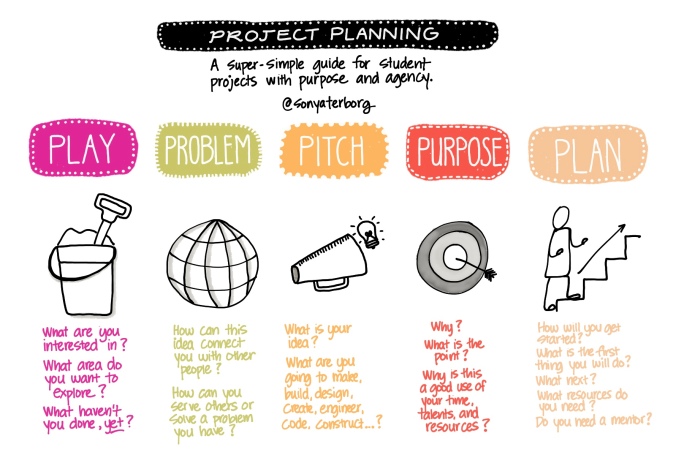I have a love/hate affair with projects.
I love them because students get to choose what they do.
I hate them because students get to choose what they do.
It boils down to three things for me: judgement, control, and fear.
I find myself checking if I think this project choice is worthy of our class time. I wonder if the project they choose is going to be something I know anything about. I am fearful that even if I overcome both these hurdles, there is still the judgement of teachers or parents who may not see the value in the project choice.
I have a long history with student choice. I won’t call it agency because, for much of the time, I found myself setting the parameters for the choices. Ultimately, I want kids to have a voice, I want them to learn through something they love to do.
My fifth grade Design students have been eager to have more say in what we do. I wanted to respect that so we started looking at what “Design” was and I opened up the floor for them to choose their next design project. But I couldn’t help myself and I started throwing in “rules” to hamper their freedom of choice. Before I knew it, I had created a framework for their projects of my making. It looks like this (and I still am not sure if I like it or not):

I created this, if I am to be honest, out of fear that should my kids stop at step one, “PLAY”, other people may judge the worthiness of them doing so. Who are these “others” that have so much control over my instinct to let my kids play, that I would go and create four more hoops for them to jump through?
This is where I am struggling at the moment in my quest for agency. Where do scaffolds come in? How can we help our students with things like authentic empathy or exposure to the Global Goals as a springboard for design? Who is to say what is purposeful and what is not?
Here is an example from one student:
After doing a “tournament of champions” with all the ideas of things that could be done in Design (similar to this one below) a student chose: Minecraft.

Students were then re-introduced to the Sustainable Development Goals (something they were already familiar with). This is where they would connect “Play” with “Problem”.
They then needed to “Pitch” an idea: what were they going to make? Do? Create? And then I wanted them to think about why? What was their “Purpose”?
Here’s one example:

“Plan” made it’s way in when I saw that many kids didn’t quite know where to get started. Or, to be fair, they did know (they started to Play!) but I wanted something more concrete.
Even as I write this I am questioning the whole thing. How much interference is too much? How much freedom is too much?
How do you make this work in your school?

I here you! Everything you have said resonates with me as I am constantly pulled by my desire to let them loose and ensure they are on the ‘right’ track.
I think each student needs guidance at a different level and our desire to support and structure their learning should be measured by the benefit it offers the students to eventually make it on their own.
I’m trying to see myself as a guide rather than a teacher where I can step in and offer opportunities for them to make progress and improve when they seem to have arrived at a point where they can’t seem to progress without my intervention. As you said, to amplify. I try to have regular mini conferences with them as they are working to see where they are at and where they want to go. Offering mini workshops also helps introduce new skills that they can then apply independently.
But it’s an ongoing headache!
By the way, I have used your project planning guide for our current Exhibition unit because I thought the students needed this level of reflection before embarking on their inquiries. It really helped to see who was more in need of support and guidance and who was ready to begin their inquiries with less questioning and support. I also use the inquiry cycle questions to help them think about the next steps their learning could take. Seeing as I am the first educator to try and help students be more self-directed in their learning in our school, the students, and I, needed to keep the level of structure in their inquiries at a certain level before letting go. Maybe it’s the Italian influence and the common saying: ‘Piano, piano!’ (‘Slowly, slowly!’) 🙂
LikeLike
I feel myself constantly torn between offering too much guidance/scaffolding and other times, not enough. Still trying to work out the sweet spot, which I’m guessing will be different for every student. Seems to me it really lies in the effective planning of a student project/inquiry/whatever. A lot of my kids are still at the ‘play’ stage.
LikeLike